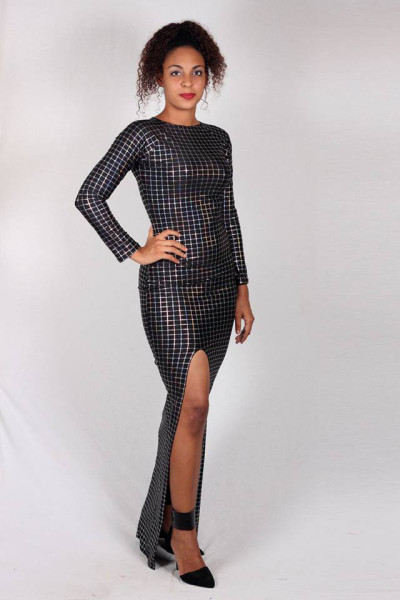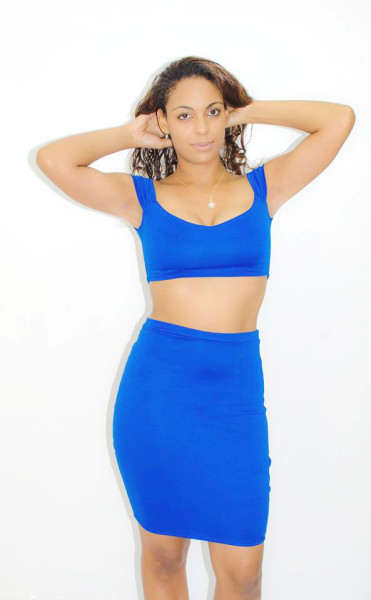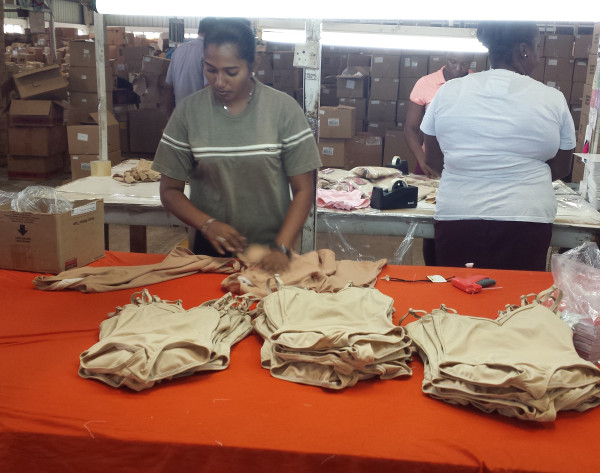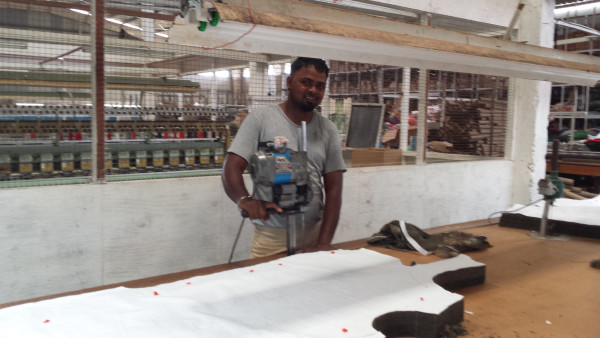Writer of The Last Word column Ashma John takes a look behind the scenes of the Guyana-based e-tailer 592 Dresses in an exclusive interview with its main mover and shaker Dason Anthony.

Most Guyanese designers and fashion retailers choose to manage their production independently or to import. Creating a business model that uses factory production for fashion has not been done before in Guyana. In fact, most of the output from local garment factories is for overseas orders.
Retailers who have a direct link with factories cut out the middleman and also stand the chance for higher profitability. However, many have opted to shy away from local factory production because of high minimum orders or the inability to create in-store lines because of consumer lust for imported goods.
I recently got the chance to have a Skype interview with Dason Anthony, a former business executive with Digicel about his start-up, 592 Dresses. 592 Dresses is an e-tailer that produces ready-to-wear garments inspired by local designers. Dason either buys the designs off designers or invites them to create a line specially for his online shop. The mainstream designs tend to be mass produced by Denmor clothing factory, while the more intricate ones are produced by an in-house production team. From my kitchen in Antwerp, while Dason sat on his couch in Georgetown, I delved into the realities of factory-produced clothing from Guyana, the mechanics behind the model, and more on 592 Dresses. (592 is, of course, Guyana’s telephone country code.)
Ashma: What stimulated your interest to get into the turbulent online retail fashion environment?
Dason: To be quite honest, for the past two years I had been thinking about entering the fashion industry. I don’t have an exact reason but I always knew I had a passion for selling and marketing.
Ashma: You have this passion, but this does not necessarily mean you have the eye. How do you go intend to fill that gap?
Dason: Well I’m hoping to collaborate with more persons, as I go along. People with more experience and knowledge of the industry.
Ashma: Is 592 limited to just dresses?
Dason: Not necessarily. Most of what is available are dresses. But it’s definitely not our only type of clothing that we look to carry.
Ashma: What would you say is the Unique Selling Point (USP) of 592 Dresses?
Dason: 592 is for a Guyanese market even though it’s online. It’s about making Guyanese designer clothes more accessible and cheaper for the masses. I must say, even though my business is online and open to serve international customers, I am not fully prepared as yet to be competing in a global market because shipping is still considerably high; even though we recently saw a reduction in rates for North America.
Ashma: So you’re looking to straighten out the kinks first before making the brand more attractive to international buyers. Would you say that you are using the Guyanese consumer as a guinea pig then?
Dason: Hmm kind of a tough way to put it. You are right in sense. However, it’s more of a research strategy and a marketing tool, I would say. I am hoping to popularize the brand within the Guyanese diaspora as I have a good base, then attach referral marketing benefits onto that.
The business model
Ashma: 592 Dresses is an e-tailer and we all know competition is stiff online. How do you intend to compete with other online retailers that your consumers are exposed to? With courier services like Zoon and so forth, the consumer is a bit spoilt for choice and many may want association with more established brands as accessibility becomes easier.
Dason: I believe there in genuine interest in creating a fashion industry and the allure of having one is even more genuine. We want the fashion hype. Whilst the competition is there and it is stiff, I plan to market the allure, the brand, around the hype created by the fashion industry. There is still need to create that in order to have a long-term relationship with the buyer. This is not set in stone but I was also [mulling]… the idea of collaborating local online shipping companies to push 592 Dresses up as a recommended option when customers go into browse and place their orders with these shipping agencies and perhaps tie a few offers into that.
Ashma: Designers in Guyana are mostly keen on commissioned work. Most of the styles you usually see are commissioned for special events and only a few focus on releasing seasonal collections. I personally find most of the work to be redundant. Do you think the current design talent is enough to foster your business and do you see yourself incorporating designers from Trinidad and across the Caribbean? Would this venture just be limited to Guyanese designers?
Dason: I don’t mind extending interest in other Caribbean designers but I am choosing to stay focused on building and exploring Guyanese talent first before I take on additional load.
Ashma: But do you think Guyanese talent is sufficient just yet?
Dason: No it’s not sufficient. Most designers usually create re-runs and it gets difficult when it comes to developing a trademark that would help them to be more desired.
Ashma: What is your collection rotation like?
Dason: This business is still in its startup phase, so I don’t have as many collections as I would want to have. For now we are focusing on the seasons where people tend to spend more on clothes. For example, Easter, Mash, Christmas and so forth.
Ashma: Many people are concerned with quality when it comes to fashion being made in Guyana, how does 592 Dresses intend overcome this?
Dason: First of all when we met Keisha, one of the designers I am currently working with, the first thing I did was to check the materials and finish. I am doing mostly all of the quality control, which can be pressuring. There is a return policy and also a review thread on the site. Reviews can work for you and I have a very hands-on approach when it comes to dealing with pieces that may not have suited the customer’s needs. Persons can state their opinions openly and freely and I will try to create improved products and services from this.
Ashma: Does 592 incorporate ethical coding in its clothes?
Dason: We are supporting Guyanese designers and bringing business back into our economy and we are looking towards using more green/eco-friendly fabrics in the future.
Factory-produced fashion
Ashma: Do you think fashion production in Guyana can become a thriving industry and can you tell us about the setbacks of producing factory style in Guyana?
Dason: I think more can be done to have it improved. While the costs are favourable and this can work in favour of competing with overpriced boutiques locally, the key problem with production in Guyana is that everything is still in the Flintstone age.
We need to incorporate technology in our processes. Everything is still being in done in a written-book format and in fashion you need to move quickly, as quickly as the trends. A lot of time is being wasted running up and down. I also think they are many gaps in careers and markets that can be filled. For instance, in most cases, the client has to provide almost everything. It would be better and more cost effective if materials can be sourced on a commercial scale. The factory has reputable relationship with brands like Reebok, New Balance. They even make the uniforms for the NYPD so you are getting quality. However, I believe more can be done to push this industry while also developing additional business channels.
Ashma: Do you think there is room for an in-house design team attached to factories like Denmor?
Dason: Definitely, more guidance is always appreciated especially in such a turbulent industry.
Ashma: You mentioned earlier on that, you don’t think that Guyana has sufficient design talent. What do you think can be done to improve this?
Dason: I think the government should be looking in the direction of getting a design school but first measuring the impact to see if it’s financially viable. If it’s not financially viable, they can also choose to invest in a select few when it comes fashion training and education. Making it in fashion today is partially luck, but now you really need the skill set not only to create but also to build the brand.
As an avid follower of fashion in the Caribbean, this really excites me! There are several reasons why I wouldn’t buy from 592 Dresses and they mostly surround my personal displeasure with the aesthetic of the brand and its variety. But there are also several reasons why this business model could potentially be one of the best startups and could navigate itself into an industry.
Dason is making designer wear available for everyone; a concept not often seen in the regional fashion community. There are however, several loopholes that need to be addressed before real development can take place. They include, but are not limited to, logistics and supply chain management, talent management and sourcing. I personally believe that while Guyana can’t be a central hub for factory produced clothes like Bangladesh and Vietnam, we can market the factories and their production as being ethical and eco-friendly as long as they fall within the parameters.
With the global push for fair salaries and better working conditions, I could see us easily being one of the places that can potentially win contracts because of the huge stigma that has been attached those countries that dominate in terms of unethical production.
This is even more interesting, particularly at a time where the government has rolled out the Hinterland Employment Youth Service (HEYS) Project, which includes garment construction training.
While there are areas that need addressing and infrastructure that’s needs developing, Dason’s 592 Dresses could possibly flip that way we consume fashion locally and even how we can invest wisely in the fashion industry as there are many gaps to be filled.










